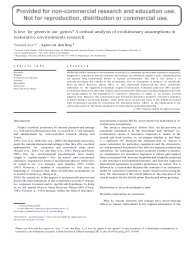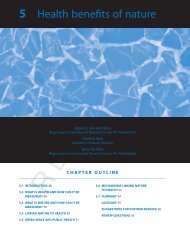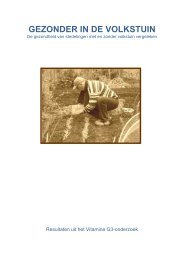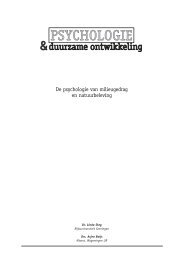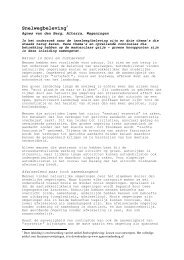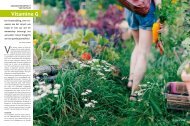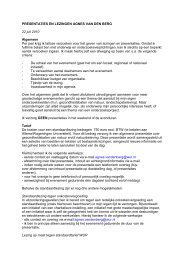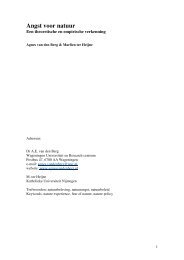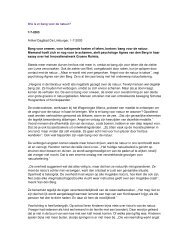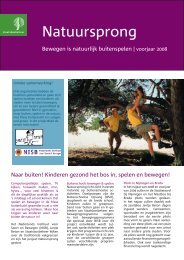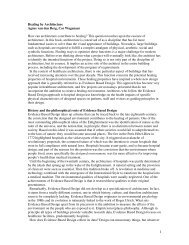New wilderness in the Netherlands - Agnes van den Berg
New wilderness in the Netherlands - Agnes van den Berg
New wilderness in the Netherlands - Agnes van den Berg
You also want an ePaper? Increase the reach of your titles
YUMPU automatically turns print PDFs into web optimized ePapers that Google loves.
A.E. Van <strong>den</strong> <strong>Berg</strong>, S.L. Koole / Landscape and Urban Plann<strong>in</strong>g 78 (2006) 362–372 363vidual differences <strong>in</strong> visual preferences for wild versus managednatural landscapes along with <strong>the</strong> potential rele<strong>van</strong>ce of place ofresi<strong>den</strong>ce, socio-economic variables, and recreational motivesto expla<strong>in</strong> <strong>the</strong>se differences. F<strong>in</strong>ally, we present <strong>the</strong> results of asurvey among 500 resi<strong>den</strong>ts from six nature development areas<strong>in</strong> The Ne<strong>the</strong>rlands.1.1. Nature development and <strong>the</strong> concept of <strong>wilderness</strong>The Dutch nature development policy can be understood aspart of an <strong>in</strong>ternational movement that has set forth ecologicalrestoration as <strong>the</strong> new standard <strong>in</strong> nature management practice(Hobbs and Norton, 1996; Davis and Slobodk<strong>in</strong>, 2004). In general,ecological restoration may be def<strong>in</strong>ed as human <strong>in</strong>tervention<strong>in</strong>tended to recover nature’s <strong>in</strong>tegrity which is considered tobe threatened or even absent because of human activities suchas agriculture, <strong>in</strong>dustry, m<strong>in</strong><strong>in</strong>g, and recreation (Swart et al.,2001). A dist<strong>in</strong>ctive characteristic of <strong>the</strong> Dutch plans for ecologicalrestoration is that <strong>the</strong> <strong>in</strong>terventions will be carried outma<strong>in</strong>ly <strong>in</strong> agricultural production areas, which will be transformed<strong>in</strong>to completely new natural areas. To achieve this,several k<strong>in</strong>ds of nature management strategies may be applied,rang<strong>in</strong>g from active strategies that guide natural processes bymeans of regulative activities, to more passive strategies thatencourage <strong>the</strong> development of spontaneous natural processes bym<strong>in</strong>imiz<strong>in</strong>g human activities <strong>in</strong> an area (cf. Hobbs and Harris,2001). Application of active nature management strategies promotes<strong>the</strong> development of orderly, managed natural landscapes,while application of more passive strategies promotes <strong>the</strong> developmentof wild, unmanaged natural landscapes. In The Ne<strong>the</strong>rlands,<strong>the</strong>se latter landscapes are commonly referred to as “new<strong>wilderness</strong> areas”.The term “new <strong>wilderness</strong>” for humanly redeveloped landscapesmay sound like a contradiction. However, this contradictiononly arises when one def<strong>in</strong>es <strong>wilderness</strong> as prist<strong>in</strong>eareas which are completely untouched by humans. The latterdef<strong>in</strong>ition is often used <strong>in</strong> legal documents (cf. <strong>the</strong> AmericanWilderness Act, 1964). However, it is also possible to def<strong>in</strong>e<strong>wilderness</strong> from a more subjective, psychological perspective.Results of landscape perception studies <strong>in</strong>dicate that lay peopleuse <strong>the</strong> term <strong>wilderness</strong> to describe any natural area withoutdiscrim<strong>in</strong>able human <strong>in</strong>fluences (Wohlwill, 1983; Kaplanand Kaplan, 1989). Thus, <strong>the</strong> appearance of an environment,ra<strong>the</strong>r than <strong>the</strong> actual amount of human <strong>in</strong>terference, determ<strong>in</strong>eswhe<strong>the</strong>r an <strong>in</strong>dividual perceives it as <strong>wilderness</strong> or not. On <strong>the</strong>basis of this psychological def<strong>in</strong>ition of <strong>wilderness</strong> it is possibleto refer to humanly redeveloped landscapes as <strong>wilderness</strong>landscapes.The planned nature development will drastically change <strong>the</strong>appearance of <strong>the</strong> Dutch countryside. Consequently, <strong>the</strong> scenicconsequences of nature development plans as <strong>the</strong>y are experiencedby those who live, work, and recreate <strong>in</strong> <strong>the</strong> designatedareas constitute an important element <strong>in</strong> land management decisions.In recognition of this notion, Dutch nature developmentpolicy has <strong>in</strong>cluded enhancement of <strong>the</strong> landscape’s scenic qualityas a criterion for environmental plann<strong>in</strong>g and managementnext to ecological criteria such as <strong>in</strong>crease of biodiversity andnaturalness. By do<strong>in</strong>g so, <strong>the</strong> Dutch government has shownan awareness that public or scenic aes<strong>the</strong>tics should be dist<strong>in</strong>guishedfrom ecological values (cf. Gobster, 1999; Parsons andDaniel, 2002). However, details on how <strong>the</strong> scenic quality criterionrelates to <strong>the</strong> various restoration options have not beenspecified. It would <strong>the</strong>refore be useful to ga<strong>in</strong> more <strong>in</strong>sight <strong>in</strong>tohow local people evaluate <strong>the</strong> scenic quality of different types ofnature development landscapes, <strong>in</strong> particular wild versus moremanaged landscapes.1.2. Visual preferencesWhen people are asked to categorize natural scenes, <strong>the</strong>y typicallyput wild, disorderly scenes toge<strong>the</strong>r <strong>in</strong> one pile, whereas<strong>the</strong>y put more managed and structured scenes toge<strong>the</strong>r <strong>in</strong> ano<strong>the</strong>rpile (cf. Hartig and E<strong>van</strong>s, 1993). Degree of human <strong>in</strong>fluencethus represents a key dimension underly<strong>in</strong>g people’s landscapeperceptions. The evaluation of this dimension varies considerablybetween <strong>in</strong>dividuals. Indeed, sett<strong>in</strong>gs reflect<strong>in</strong>g ei<strong>the</strong>r lowor high degrees of human <strong>in</strong>fluence tend to elicit <strong>the</strong> most <strong>in</strong>dividualvariation <strong>in</strong> environmental preferences (Dear<strong>den</strong>, 1984;Gallagher, 1977; Orland, 1988; Strumse, 1996). Accord<strong>in</strong>gly,<strong>the</strong>re exist important <strong>in</strong>dividual differences <strong>in</strong> visual preferencesfor wild versus more managed natural sett<strong>in</strong>gs.Kaplan and Kaplan (1989) have reviewed <strong>the</strong> available evi<strong>den</strong>ceon <strong>in</strong>dividual differences <strong>in</strong> landscape preferences. Theiranalysis suggests that differences between members of varioussubcultures and ethnic groups can nearly always be <strong>in</strong>terpreted <strong>in</strong>terms of <strong>the</strong> preferred balance between natural and human <strong>in</strong>fluences.Some <strong>in</strong>dividuals tend to display a preference for wildnatural landscapes, whereas o<strong>the</strong>rs tend to display a preferencefor more managed nature. Unfortunately, <strong>the</strong> studies reviewedby Kaplan and Kaplan (1989) do not allow any firm conclusionsconcern<strong>in</strong>g <strong>the</strong> cultural or ethnic variables that underlie <strong>the</strong>se differences,because <strong>the</strong> subcultures and groups that were studieddiffered on more than one dimension (e.g., urbanity, familiarity,age, race, <strong>in</strong>come). In <strong>the</strong> follow<strong>in</strong>g paragraphs, we consider <strong>the</strong>empirical evi<strong>den</strong>ce for three types of variables that are oftenmentioned as possible correlates of <strong>in</strong>dividual differences <strong>in</strong>preferences for wild versus managed natural landscapes: placeof resi<strong>den</strong>ce, socio-economic characteristics, and recreationalmotives.1.3. Place of resi<strong>den</strong>ceA first potential source of <strong>in</strong>dividual differences <strong>in</strong> preferencefor wild versus managed nature is place of resi<strong>den</strong>ce. Studiesamong rural resi<strong>den</strong>ts have sometimes reported negative evaluationsof plans to protect or develop nearby <strong>wilderness</strong> areas(e.g., Fiallo and Jacobsen, 1995; Durrant and Shumway, 2004).For example, results of a recent survey <strong>in</strong>dicated that resi<strong>den</strong>tsof six south-eastern Utah counties displayed negative attitudestoward <strong>the</strong> designation of <strong>wilderness</strong> study areas <strong>in</strong> <strong>the</strong>ir county(Durrant and Shumway, 2004). Such negative attitudes havebeen attributed to perceived impacts on livelihoods or disagreementwith local plann<strong>in</strong>g procedures, which may give rise to a‘resistance to change’.



